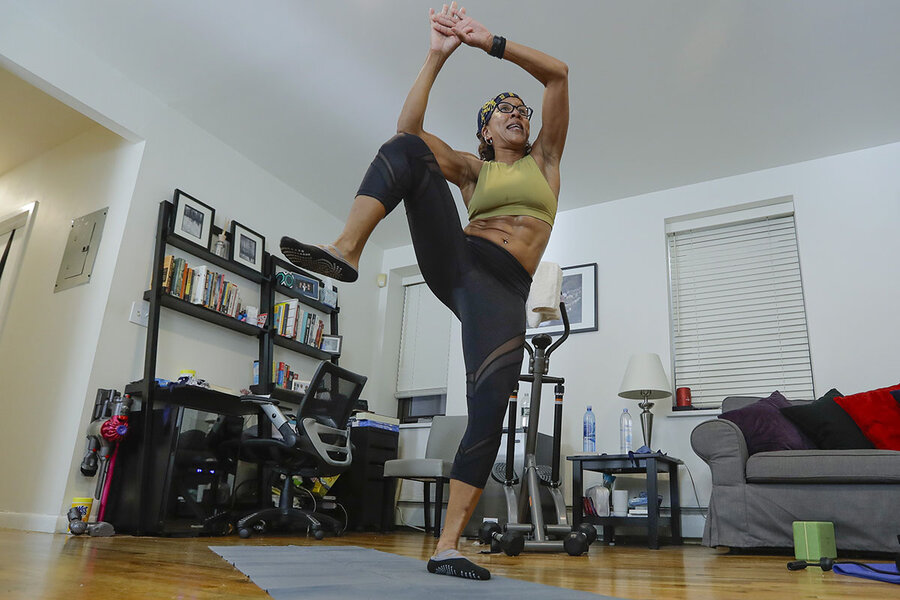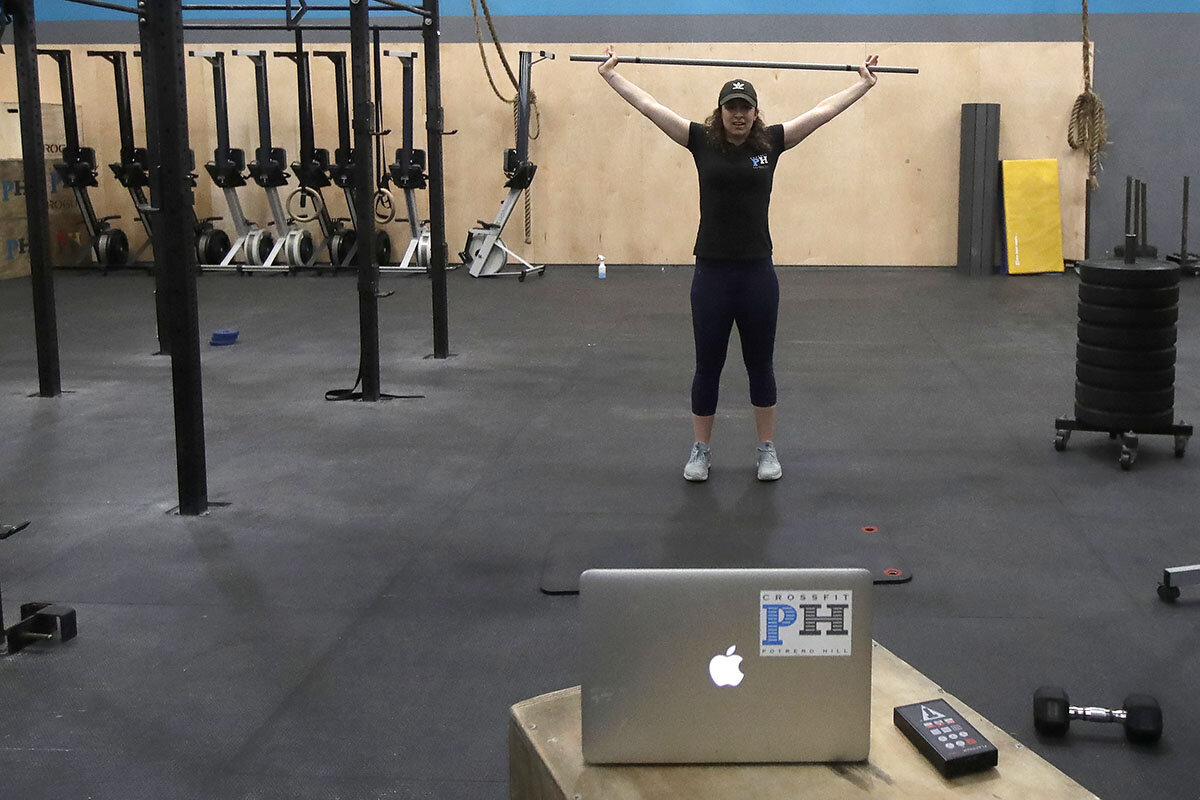The pandemic took my spin class: How homebound workouts are working out
Loading...
Linda Vilagi built her personal training and fitness business like anyone else – working with clients in-person in gyms.
When strict lockdowns rolled out last March, she started hosting fitness classes online not as a sustainable business model, but “as a way to keep everyone moving, and their minds occupied.” As the pandemic stretched on, however, Ms. Vilagi realized that there was a completely new market to tap into, if she could figure out how to inspire and forge connections through tiny Zoom windows the same way she did in person.
So she launched Linda’s Fit Club, where she offers live and recorded group workout classes six days a week to clients across the United States and the world. It’s a vast geographic expansion from her previous business, based around Cleveland.
Why We Wrote This
How is the pandemic helping people think differently about where and how they connect with people and pastimes? For some, it’s an exercise in problem-solving.
Through the pandemic, extended gym closures have caused a shift in how some people like Ms. Vilagi and her clients are approaching home fitness routines – a shift that the fitness industry has been swift to move into. From buying up weights to using exercise apps to connecting with groups online, the popularity of amped-up home workouts may be permanent.
“The fitness lifestyle has fundamentally changed because of the length of the pandemic, and I really believe that these new habits are going to be solidified,” Ms. Vilagi says. After 15 years as an in-person trainer, she says she’s found the transition to online remarkably easy. “I think that you’ll see a hybrid approach [of in-home and in-gym training] moving forward.”
Equinox and Gold’s Gym had started expanding their at-home offerings in recent years, and virtual fitness classes were a growing niche trend. But “I don’t think it would have caught on as quickly as it has” without the lockdowns, Ms. Vilagi says. Her classes are still going strong.
Sales across all categories of fitness equipment had risen 130% by May of 2020, including weight benches, free weights, stationary bikes, and yoga mats, according to market research firm NPD Group. Peloton, which sells top-end stationary bikes, treadmills, and subscriptions to online workouts, quadrupled subscriptions to its app last year and anticipates continued revenue growth through fiscal year 2021 to the tune of at least $3.9 billion.
Other companies are also betting on efforts with a high-tech edge. Mirror, Tempo, and Tonal all produce smart home gyms with a mirror-size profile. Like brick-and-mortar gyms, these companies predate the pandemic. Their devices can display stats and workout moves, as well as offer a mix of artificial intelligence-based and livestreamed classes, depending on the brand. Apple has also stepped into the fitness streaming game with its paid subscription service, Apple Fitness+.
Used to working out five to six times a week, Shadya Sanders began doing exercises from memory in her Rockville, Maryland, living room at the start of the pandemic. When she got tired of kickboxing, she switched to jumping rope. Then she thought she’d start lifting weights.
“You couldn’t get kettlebells, you couldn’t get dumbbells when I was looking for them,” says Ms. Sanders, a doctoral candidate in atmospheric sciences at Howard University. She resorted to lifting household items, like five-gallon water jugs. But then she got an email from the university announcing Beyoncé had partnered with Peloton and was offering a free two-year membership for Howard students.
“I downloaded the app and everything and put it on our TV, so now me and my family will do these workouts – arm toning, leg strengthening, or a mix of a couple of 10 minutes workouts. I love Beyoncé, and even more now,” Ms. Sanders says.
Users are also turning to free apps to record or even lead their workouts. The fitness tracking app Strava recorded 2 million new users each month during 2020, and attributed “a boom in global exercise amid the COVID-19 pandemic” for part of its growth. Elsewhere, people tuned in to trainers’ personal online platforms.
“I have most of these online coaches on both YouTube and Instagram that I look at,” says Ikem Ejimnkeonye, a police officer in Prince George’s County, Maryland, talking to the Monitor on the phone as his baby daughter coos in the background. “They give pointers on types of exercises that you can do during the pandemic.”
For those new to working out at home, Ms. Vilagi says not to overthink things. Body weight exercises – planks, push-ups, squats, and lunges – are great for beginners and those without equipment. Online classes, or even traditional home workout programs that have been around for decades and debuted on VHS or DVD, such as Beachbody, can keep things fresh for people who might get bored easily.
But the live classes, because they can build community, especially help with accountability, she and others say. Members of her online offerings have grown close, Ms. Vilagi says. “If someone doesn’t show up to class,” she explains, “someone else will say to me, ‘Hey is Lori OK? I haven’t seen her in a couple days.”
That sense of community is also cited by some people who – drawn to working out with others for the camaraderie and motivation – are eager to get back to the local gym. Ms. Sanders joined outside group exercise classes at her local fitness center in the fall. Some of those classes have now transitioned inside because of the cold, adopting strict protocols such as signing up 24 hours before a class, wearing a mask, and taking participants’ temperature at the door.
But given the time, money, and effort invested in establishing new workout routines over the past year, some people might not revert to their pre-pandemic fitness habits – at least not fully. In New Jersey, Maron Soueid, who built a set of pull-up bars in his backyard over the summer, says he doesn’t plan on forgetting about his pandemic-inspired handiwork.
“I might not spend as much time at the gym, now that I have the convenience of this pull-up bar at home,” says Mr. Soueid, an adjunct professor at a local community college. “I still fully expect it – especially during the summer – to be used quite often.”






